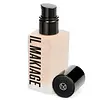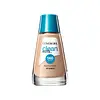Il Makiage GL Radiant Glow Woke Up Like This Foundation Versus Covergirl Clean Matte Liquid Foundation
What's inside
What's inside
 Key Ingredients
Key Ingredients

 Benefits
Benefits

 Concerns
Concerns

 Ingredients Side-by-side
Ingredients Side-by-side

Water
Skin ConditioningCyclopentasiloxane
EmollientIsododecane
EmollientGlycerin
HumectantAlcohol
AntimicrobialPhenyl Trimethicone
Skin ConditioningAluminum Starch Octenylsuccinate
AbsorbentBis-Hydroxyethoxypropyl Dimethicone/Ipdi Copolymer Ethylcarbamate
Cetyl PEG/PPG-10/1 Dimethicone
EmulsifyingDisteardimonium Hectorite
StabilisingSodium Chloride
MaskingPolyglyceryl-4 Isostearate
EmulsifyingHexyl Laurate
EmollientDi-C12-13 Alkyl Tartrate
EmollientSodium Dehydroacetate
PreservativePotassium Sorbate
PreservativeDisodium Stearoyl Glutamate
CleansingDiamond Powder
AbrasiveCaprylic/Capric Triglyceride
MaskingAluminum Hydroxide
EmollientPentaerythrityl Tetra-Di-T-Butyl Hydroxyhydrocinnamate
AntioxidantRubus Idaeus Leaf Cell Culture
Skin ConditioningCI 77891
Cosmetic ColorantCI 77491
Cosmetic ColorantCI 77492
Cosmetic ColorantCI 77499
Cosmetic ColorantWater, Cyclopentasiloxane, Isododecane, Glycerin, Alcohol, Phenyl Trimethicone, Aluminum Starch Octenylsuccinate, Bis-Hydroxyethoxypropyl Dimethicone/Ipdi Copolymer Ethylcarbamate, Cetyl PEG/PPG-10/1 Dimethicone, Disteardimonium Hectorite, Sodium Chloride, Polyglyceryl-4 Isostearate, Hexyl Laurate, Di-C12-13 Alkyl Tartrate, Sodium Dehydroacetate, Potassium Sorbate, Disodium Stearoyl Glutamate, Diamond Powder, Caprylic/Capric Triglyceride, Aluminum Hydroxide, Pentaerythrityl Tetra-Di-T-Butyl Hydroxyhydrocinnamate, Rubus Idaeus Leaf Cell Culture, CI 77891, CI 77491, CI 77492, CI 77499
Water
Skin ConditioningCyclopentasiloxane
EmollientPropylene Glycol
HumectantTalc
AbrasiveGlycerin
HumectantPEG/PPG-18/18 Dimethicone
EmulsifyingCetyl Ethylhexanoate
EmollientCyclomethicone
EmollientMagnesium Sulfate
Silica
AbrasiveLaureth-7
EmulsifyingArachidyl Behenate
EmollientSodium Dehydroacetate
PreservativeTrihydroxystearin
Skin ConditioningPropylparaben
PreservativeMethicone
EmollientIsopropyl Titanium Triisostearate
EmollientMethylparaben
PreservativeSynthetic Wax
AbrasiveTrisodium EDTA
Ethylene Brassylate
MaskingStearic Acid
CleansingTitanium Dioxide
Cosmetic ColorantIron Oxides
Mica
Cosmetic ColorantWater, Cyclopentasiloxane, Propylene Glycol, Talc, Glycerin, PEG/PPG-18/18 Dimethicone, Cetyl Ethylhexanoate, Cyclomethicone, Magnesium Sulfate, Silica, Laureth-7, Arachidyl Behenate, Sodium Dehydroacetate, Trihydroxystearin, Propylparaben, Methicone, Isopropyl Titanium Triisostearate, Methylparaben, Synthetic Wax, Trisodium EDTA, Ethylene Brassylate, Stearic Acid, Titanium Dioxide, Iron Oxides, Mica
 Reviews
Reviews

Ingredients Explained
These ingredients are found in both products.
Ingredients higher up in an ingredient list are typically present in a larger amount.
Cyclopentasiloxane, or D5, is a silicone used to improve texture of products and trap moisture.
D5 is considered lightweight and volatile. Volatile means it evaporates quickly after application. Once evaporated, D5 leaves a thin barrier that helps keep skin hydrated.
It is also an emollient. Emollients help soften the skin and prevent water loss. Silicones create a silky texture in products. D5 helps other ingredients become more spreadable.
Studies show D5 is safe to use in skincare products. We recommend speaking with a skincare professional if you have concerns.
Learn more about CyclopentasiloxaneGlycerin is already naturally found in your skin. It helps moisturize and protect your skin.
A study from 2016 found glycerin to be more effective as a humectant than AHAs and hyaluronic acid.
As a humectant, it helps the skin stay hydrated by pulling moisture to your skin. The low molecular weight of glycerin allows it to pull moisture into the deeper layers of your skin.
Hydrated skin improves your skin barrier; Your skin barrier helps protect against irritants and bacteria.
Glycerin has also been found to have antimicrobial and antiviral properties. Due to these properties, glycerin is often used in wound and burn treatments.
In cosmetics, glycerin is usually derived from plants such as soybean or palm. However, it can also be sourced from animals, such as tallow or animal fat.
This ingredient is organic, colorless, odorless, and non-toxic.
Glycerin is the name for this ingredient in American English. British English uses Glycerol/Glycerine.
Learn more about GlycerinThis ingredient is a preservative with antimicrobial properties. It is the sodium salt of dehydroacetic acid.
It is especially effective at preventing bacterial and fungal growth in low concentrations.
Water. It's the most common cosmetic ingredient of all. You'll usually see it at the top of ingredient lists, meaning that it makes up the largest part of the product.
So why is it so popular? Water most often acts as a solvent - this means that it helps dissolve other ingredients into the formulation.
You'll also recognize water as that liquid we all need to stay alive. If you see this, drink a glass of water. Stay hydrated!
Learn more about Water